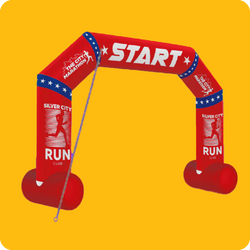Securing a Canopy Tent Made Easy

Setting up a canopy tent can be a breeze if you know the right techniques. Ensuring it stays put, even in strong winds, is crucial for the success of any event.
Are you preparing for a trade show, outdoor market, or promotional event? This guide will help you securely tie down your canopy tent, keeping your booth space in business and safe and employees.
You'll learn different methods to stabilize your tent to suit various environments and weather conditions. Discover the best tools and techniques and how to use them effectively. With these tips, you'll ensure your setup remains secure and inviting. By the end, you'll be confident in handling any setup challenge.
Comparing Different Methods of Tying Down Your Canopy
Securing your pop-up custom canopy tent properly is key. Different tools and methods offer varying levels of difficulty and security.
Stakes and Pegs
Stakes and pegs are easy to use. Simply drive them into the ground. Tents designed for promotion should come with loops for you to drive stakes at intervals along the tent.
Stakes work well on grass or dirt. They also provide good stability in mild weather and are best suited for soft ground conditions.
The pros of using stakes and pegs include easy installation and affordability. However, they are unsuitable for hard surfaces and can loosen in strong gusts of winds.
Weights and Sandbags
These are easy to place around the canopy legs. Just fill them with sand or water. They are very effective for adding stability to any surface, making them ideal for concrete, asphalt, and other hard surfaces.
You can find weights and sandbags that are specially designed for canopy tents.
Weights and sandbags are versatile, suitable for all surfaces, and easily adjustable. The downsides include being heavy to transport and requiring filling.
Guy Lines and Ropes
These require some skills to tie securely. The best results are obtained using a hitch knot.
They are excellent in high-wind conditions and add extra stability by anchoring to the ground. Tent guy lines and ropes are beneficial because they are highly effective in strong winds and add stability. However, they require proper tying techniques and can be a tripping hazard.
Bungee Cords and Ratchet Straps
Bungee cords and straps are easy to attach and provide quick and strong securing options. They are good for keeping the canopy tight and stable, and they can be quickly set up in moderate weather.
The pros of bungee cords and ratchet straps include their quick and easy use and adjustable tension. However, they are not as strong as guy lines in high winds, and bungee cords can wear out over time.
Understanding Your Event Environment
The environment of your event greatly impacts how you should secure your instant canopy tent. Different factors like wind speed, ground type, and weather conditions require different securing methods.
Wind Speed
High wind speeds demand stronger securing methods. Use heavy-duty stakes, guy lines, and ratchet straps in strong winds. Sandbags and weight bags also help stabilize the tent. For mild winds, basic stakes and canopy weights may suffice.
Ground Type
The type of ground affects your choice of anchors:
- Soft ground (grass, dirt): Stakes and pegs work best. They dig into the soil and hold the tent in place. These weights hold the tent securely on hard surfaces.
- Sand (beach): Use long stakes or specialized sand anchors. Bury weights or sandbags to ensure stability.
Weather Conditions
Weather conditions play a big role in tent security:
- Rain: Wet ground can loosen stakes. Use additional weights to prevent the tent from shifting.
- Sun: Heat can expand materials. Check and tighten all straps and lines periodically.
- Strong winds: Use all available methods–stakes, weights, guy lines, and straps.
Before setting up, examine your environment. Check the wind forecast to see if strong winds are expected. Examine the ground to determine if it's soft, hard, or sandy. Prepare for different weather conditions, such as rain, sun, and wind.
Specific Scenarios
- Park: Stakes and pegs work well on grass. Add weight bags for extra security. Use guy lines if you expect wind.
- Trade Show: Use sandbags or weight bags on hard surfaces. Ratchet straps help keep the tent taut. Ensure walkways are clear to avoid tripping hazards.
- Urban Setting (Block Events on Pavement or Parking Lots): Use heavy weights like water-filled 5-gallon buckets. Secure with bungee cords or ratchet straps. Anchor to nearby structures if allowed.
Steps to a Secure and Safe Booth Space
Securing your canopy tent is crucial for a safe and successful event. Follow these steps to ensure your booth space stays secure.
Step 1: Assess the Site
Start by checking the ground. Determine if you're setting up on grass, sand, or concrete. Soft ground, like grass or dirt, will need stakes. Hard surfaces, such as concrete, will need weights. Next, evaluate the weather. Check the wind speed and prepare for any rain or strong winds impacting your setup.
Step 2: Gather Your Accessories
Gather all the tools you'll need. Spike and rope sets are ideal for soft ground, weights and sandbags work perfectly for hard surfaces, guy lines and ratchet straps add extra stability, and tent stakes and pegs are essential for securing your tent on soft ground. Ensure you have everything ready before you begin.
Step 3: Secure the Canopy Legs
For grass or dirt, use tent stakes. Drive them into the ground at a 45° angle for maximum hold. Attach guy lines to the tent poles for additional security. On the sand, use long stakes or sand anchors. Bury sandbags deep to add weight and keep the tent stable. On concrete, place weight bags or sandbags at each tent leg.
Step 4: Add Extra Stability
Attach guy lines to the top corners of your canopy. Secure them to stakes or heavy objects on the ground to provide additional stability. Use bungee cords, ropes, or ratchet straps to tighten and secure the canopy. Check all connections to ensure stability.
Step 5: Install Sidewalls
Add sidewalls to your canopy tent. They provide extra wind resistance and help stabilize the structure. Attach the sidewalls securely to the frame tent to ensure they stay in place.
Step 6: Double Check Everything
Finally, walk around your tent and check that all stakes, tent weights, and lines are secure. Make sure nothing is loose or wobbly. This final check ensures that your tent remains stable and secure throughout the event.
Keep Your Canopy Tent Secure
Securing your canopy tent is vital for a successful event. You've learned the various methods to tie down your tent and the importance of understanding your event environment. You've gotten through a detailed step-by-step guide to keep your booth space safe and stable, and now you're more prepared with tips for different surfaces and essential accessories.
Are you ready to secure your canopy tent with confidence? Explore our collection of canopy tent accessories to find everything you need for a safe and successful setup. Make your next event a breeze with Look Our Way!
































